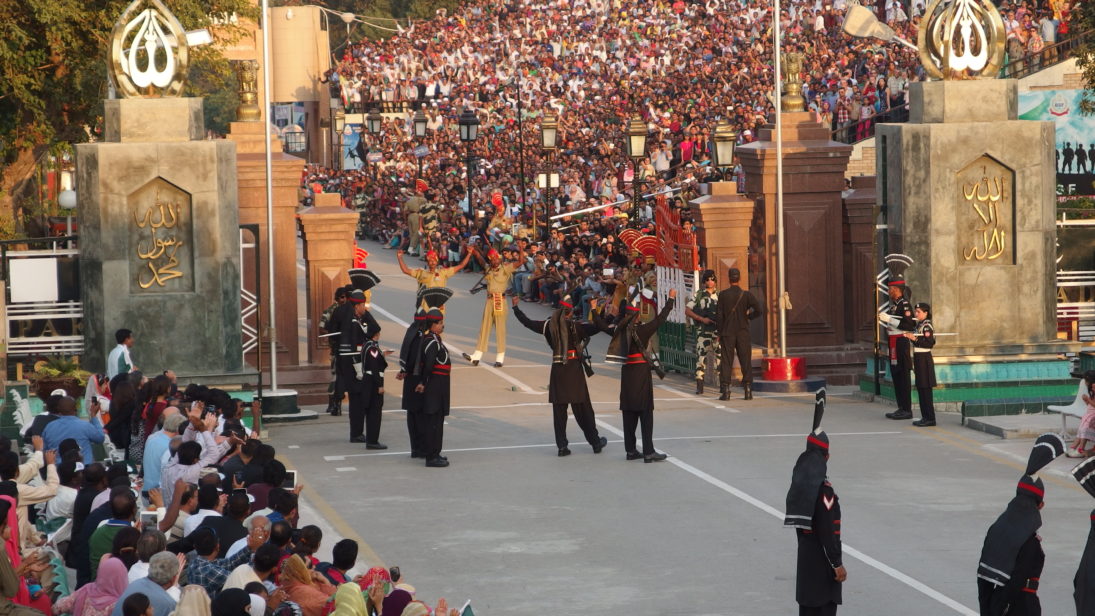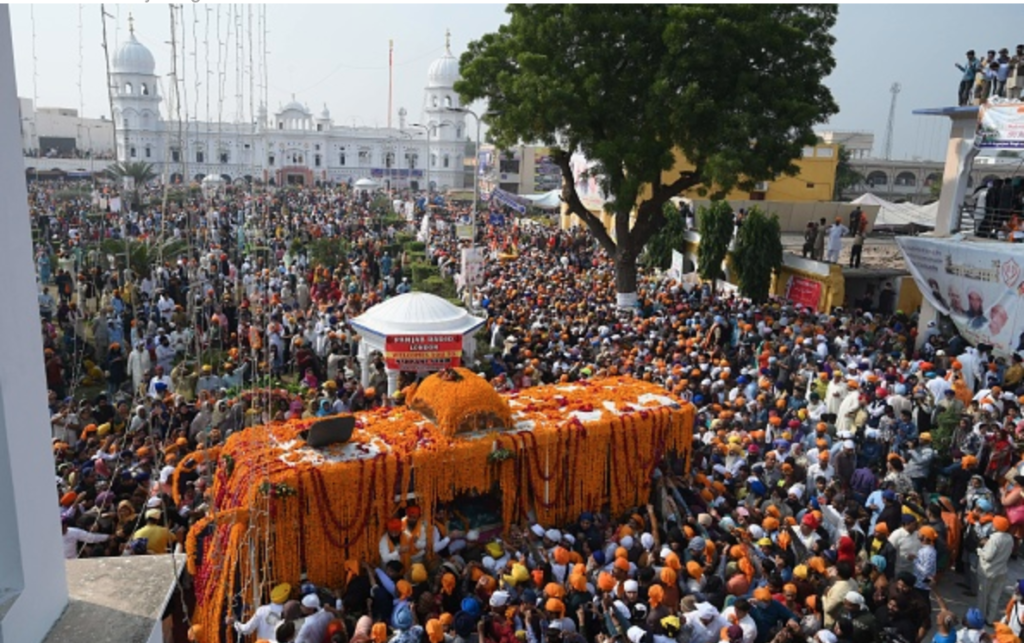
Since the partition of Punjab—a consequence of the wider India-Pakistan partition in 1947—the “Land of Five Waters” has been the focal point of a war-inducing water dispute and widespread bloodshed. Conservative estimates put the death toll within Punjab during the events of partition at 180,000. Once the vibrant political, economic, and cultural hub of the Mughal Empire, it was reduced to unspeakable horrors. Difficult as it is to imagine, Muslims, Hindus, and Sikhs coexisted relatively peacefully pre-colonization before artificial and hierarchies were forced upon them by the British.
However, despite the uprooting of families, displacement of millions, forced mass conversions, and current draconian visa policies, Pakistani and Indian Punjab are united by the common thread of culture. Amidst increasing tensions between New Delhi and Islamabad, a sense of brotherhood has persisted between the partitioned Punjabs. Local cuisine, high-spirited dance, and spoken language remain largely the same. Recently, the Pakistani government has made efforts to reunite both Punjabs by initiating the landmark Kartarpur Corridor that connects Sikhs in Indian Punjab to the sacred shrine of Gurdwara Darbar Sahib in Kartarpur, Pakistan. Though initiated by the national government, the Kartarpur Corridor could constitute a key form of subnational diplomacy between both provinces. The heavy militarization of the Wagah Border—the major crossing between India and Pakistan—stands in contrast to the relatively less policed Kartarpur Corridor providing Sikhs with the opportunity to cross over the India-Pakistan border peacefully. It is yet to be seen if this effort to initiate subnational diplomacy in Punjab bears fruit in the context of increasing religious polarity at the national level.
Bound by Culture, Separated by Borders
Lahore and Amritsar are a mere 50 kilometers apart. However, journeys between the two cities are among the most difficult to complete—this is not because of rough terrain or lack of transport infrastructure, but instead the deep-rooted, seemingly indefinite Pakistan-India political rivalry. Commonly referred to as twin cities due to their strikingly similar shape and historical structures, Lahore and Amritsar lay bare the violence and brutality imposed on tens and thousands of innocent civilians crossing the hastily drawn India-Pakistan border in August 1947. Bedian Road Lahore—named after descendants of Guru Nanak, the father of Sikhism—once connected Lahore to Amritsar but now stops short of the highly securitized India-Pakistan border. The visa policies of both nations severely restrict, if not altogether ban, cross-border movement, even between Punjabi villages only a few kilometers apart but separated by the Wagah border. This heightens sensitivities about minute differences in culture by “othering” those across the border despite commonalities spanning language, food, music, cinema, and attitude.
The visa policies of both nations severely restrict, if not altogether ban, cross-border movement, even between Punjabi villages only a few kilometers apart.
Theatre of Conflict
While Lahore, the capital of a then united Punjab, served as the center of the Mughal Empire and seat of Mughal officials, religious divides threatened peaceful coexistence between Muslim, Hindu, and Sikh Punjabis well before Partition. Mughal Emperor Aurangzeb’s brutal rule set the stage for deep-rooted resentment between both communities. Imposing heavy taxes on Sikhs and Hindus and murdering a Sikh Guru directly contributed to the creation of the anti-Mughal Khalsa united, which posed Muslims as the “other.” Fast-forwarding to the partition era, Punjab remained one of the most heavily contested regions after Kashmir. Its strategic and economic importance as the agricultural core—home to the five major rivers on the subcontinent—caused much debate and bloodshed during and after partition.
Kashmir was the trigger for all but one major war between India and Pakistan yet Punjab, because of its strategic importance and high population density often became a high-stakes theater of conflict. As a response to Pakistan’s infiltration of forces in Kashmir in the 1965 Indo-Pakistan war, India escalated fighting and attacked military bases in Lahore precipitating the start of the first “full-fledged war” between both nations. Pakistan’s celebration of Defence Day on September 6 signifies this remarkable battle in the nation’s most populated and politically important province.
While military clashes are noteworthy, disputes over river distribution remain most threatening to Punjab’s fortunes. As recently as 2016, India threatened to revoke the Indus Water Treaty that regulates the distribution of the six major rivers, namely the eastern rivers of Beas, Ravi, and Sutlej and the western rivers of Indus, Chenab, and Jhelum, passing through the Indian subcontinent as a response to the Uri attack. Similarly, after the 2019 Pulwama attacks, the Indian Minister of Roads and Water Resources decided to redistribute water flowing from three of the rivers into Pakistan to Haryana, Punjab.
Since then, India has also refused to provide water flow data to Pakistan that helps prepare for monsoon floods. Pakistan has blamed India for violating the treaty whereas India blames the treaty itself for allocating an unreasonable amount to Pakistan. The macro-political water security disputes and general mismanagement of water flows have adversely impacted Punjabi farmers and river-dependent civilians on both sides. Recent efforts to revive the Indus Water Commission post-Pulwama seem unlikely to succeed as Pakistan asks India to resolve the Kashmir dispute before expecting further dialogue on the issue.

The Kartarpur Corridor
Despite complicated security dynamics, the culture-religious history could be used as a tool to bridge post-partition barriers if operated under a subnational framework. A watershed moment for cultural reunification and exchange in the history of Pakistan and Indian Punjab came in November 2019, when Pakistan established a visa-free border crossing connecting the holy Gurdwara Darbar Sahib to Indian Sikh Pilgrims. However, soon after the corridor’s inauguration, the pandemic and subsequent back and forth between the Indian and Pakistani governments over international travel led to the temporary closure of the border crossing.
In August 2021, Pakistan claimed that the corridor was technically open to Indian Sikh pilgrims but the Indian government refused to reopen its borders to allow pilgrimage. Although Pakistan has announced it will allow fully vaccinated Sikh pilgrims to visit Kartarpur for the death anniversary of Guru Nanak through the corridor on September 21, the Indian government has yet to officially reopen the corridor despite pressure from Indian Punjab officials. In this context of national governments deciding on an inherently subnational issue, some have argued that the establishment of the corridor was an isolated event and access to Sikh spaces and general Punjab-to-Punjab has only been momentarily regained.
The question remains whether India and Pakistan’s recent half-hearted effort to promote intercultural ties can last against the backdrop of increasing hostility and discrimination against minorities in both nations.
Whether the corridor is functional by September 21 or not, the question remains whether India and Pakistan’s recent half-hearted effort to promote intercultural ties can last against the backdrop of increasing hostility and discrimination against minorities in both nations. Frequent killings of Pakistani Sikh traders during the height of terrorism in and around Peshawar instilled fear in the Sikh community across the country. The resurgence of the Taliban in Pakistan could bring about another wave of mass targeted killing of religious minorities. Thus, the Pakistani government’s tacit support of the Taliban regime cancels out any cultural exchange efforts on the Kartarpur Corridor. Similarly, the Modi government’s controversial agricultural laws that devastate the earnings of local farmers—most from Punjab—calls his government’s concern for Indian Sikh citizens into question.
Conclusion
Determined subnational diplomacy efforts could resolve most inter-regional issues and create space for meaningful exchanges. The two provincial governments could convene on a bi-yearly basis to discuss water security, immigration rights, unrestricted access to sacred spaces, family reunification, inter-educational opportunities, and cultural and historical tours. Specifically, cross-border training of professionals and students from both regions on water management techniques, water flow analysis, and disaster mitigation could address issues of misinformation and miscalculations.
Bi-national cultural tours and educational activities spanning the historical roots of the region could encourage newer generations to push for more engagement and cohesion. A peaceful Punjab region could prevent bi-national conflicts from spilling over into the region and, as both Punjabs border the seat of governments in Delhi and Islamabad respectively, regional bonhomie is likely to influence central government attitudes. The cultural fabric of the region, unraveled by unnecessary bloodshed and destruction, can be rewoven if both countries localize solutions and actively encourage cross-border exchanges. The untying of Punjab’s political knots is necessary to sustain internal and binational peace and stability.
Editor’s Note: This article is part of a joint-series run with 9DashLine exploring the role of subnational diplomacy in South Asia.
***
Image 1: Wikimedia Commons
Image 2: Arif Ali/AFP via Getty Images


